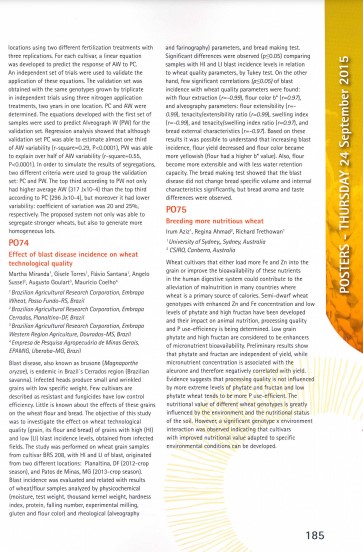
Effect of blast disease incidence on wheat technological quality
Blast dísease, also known as brusone (Magnaporthe oryzae), is e.ndemic in Brazil"s Cerrados region (Brazilían savanna). Infected heads produce small and wrinkled grains with low specifíc weight. Few cultivars are described as resistant and fungicides have low control efficíency. Little is known about the effects of these grains on the wheat flour and bread. The objective of this study was to investigate the effect on wheat technological quality (grain, its flour and bread) of grains with hígh (HI) and low (LI) blast incídence levels, obtained from infected fields. The study was performed on wheat grain samples from cultivar BRS208, with HI and LI of blast, origínated from two different locations: Planaltina, DF (2012-crop
season), and Patos de Minas, MG (2013-crop season). Blast incidence was evaluated and related with results of wheat/flour samples analyzed by physicochemical (moisture, test weight, thousand kernel weight, hardness index, protein, falling number, experimental milling, gluten and flour color) and rheologícal (alveography and farinography) parameters, and bread making test. Significant differences were observed (pSO.05) comparing samples with HI and LI blast incidence levels in relation to wheat quality parameters, by Tukey test. On the other hand, few significant correlations (pSO.05) of blast incidence with wheat quality parameters were found: with flour extraction (r=-0.99), flour color b* (r=0.97),
and alveography parameters: flour extensibility (r=- 0.99), tenacity/extensibility ratio (r=0.99), swelling index (r=-0.99), and tenacity/swelling índex ratio (r=0.97), and bread externa I characteristics (r=-0.97). Based on these results it was possible to understand that increasing blast incidence, flour yield decreased and flour color became more yellowish (flour had a higher b* value). Also, flour become more extensible and with less water retention capacity. The bread making test showed that the blast disease did not change bread specific volume and internal characteristics significantly, but bread aroma and taste differences were observed.

A Rede Fitossanidade Tropical (RFT) é uma iniciativa brasileira de trabalho cooperativo, com objetivo de gerar e transferir informações relevantes, baseadas nas descobertas em pesquisas aplicadas numa importante subárea das ciências agrárias e agronomia, a fitossanidade.
Últimas notícias
Menu
Contato
Se tiver alguma dúvida ou quiser conversar conosco sobre parcerias e oportunidades, envie-nos um e-mail. Teremos o maior prazer em responder.
-
contato@fitossanidadetropical.org.br

